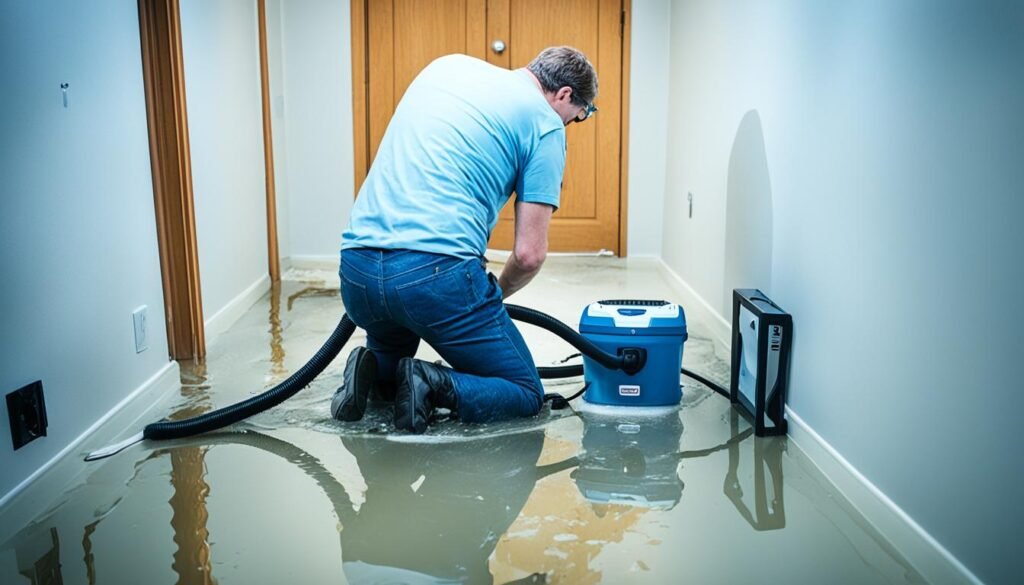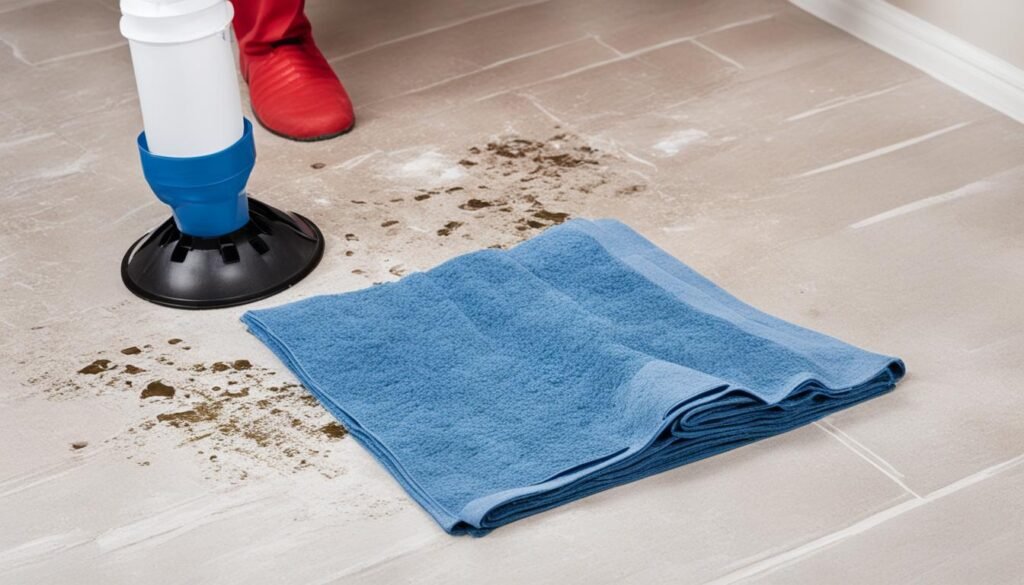Did you know that water damage is one of the most common and costly home insurance claims in the United States? Every year, millions of homeowners face the devastating effects of water damage, which can lead to structural issues, mold growth, and even health hazards. Acting quickly and implementing quick fixes can help minimize the impact of water damage while waiting for professional restoration services.
Key Takeaways:
- Water damage is a common and costly issue that many homeowners face.
- Taking immediate action and implementing quick fixes can help minimize the impact of water damage.
- Waiting for professional restoration services is crucial, but there are steps you can take to prevent further damage in the meantime.
- Understanding the type of water involved and assessing the extent of the damage is essential for effective repairs.
- Consulting professionals for water damage repair and restoration will ensure thorough and effective results.
Assessing and Addressing Water Damage
When faced with water damage, it’s crucial to assess the situation promptly and determine the necessary steps for effective repair and restoration. The type of water involved plays a significant role in the level of response required. There are three types of water damage: clean water, gray water, and black water.
- Clean water: This category refers to water from a clean source, such as a broken pipe or faucet leak. You can generally address clean water damage on your own, following appropriate safety precautions.
- Gray water: Gray water is slightly contaminated and may contain chemicals or bacteria. It typically stems from sources like washing machines or dishwashers. In cases of gray water damage, it’s advisable to seek professional assistance from a water damage restoration company.
- Black water: Black water is heavily contaminated and poses serious health risks. It often contains sewage, chemicals, or other hazardous substances. Dealing with black water damage requires the expertise of professionals who specialize in emergency water damage repair.
Repair Process
Once you have determined the type of water damage, you can begin the repair process. Here are the key steps involved:
- Drying out the affected area: Use fans, dehumidifiers, and open windows to facilitate drying and prevent further damage.
- Removing and discarding damaged materials: Dispose of carpets, furniture, and other items that cannot be salvaged due to extensive water damage.
- Disinfecting the space: Clean and disinfect surfaces to prevent the growth of mold, bacteria, and other pathogens.
- Addressing specific areas: Pay attention to specific areas like ceilings, wood, and drywall to ensure thorough repair and restoration.
It’s important to note that water damage repair should be carried out as soon as possible to prevent further deterioration of the affected area and mitigate potential health hazards.
Insurance Coverage
Checking your insurance coverage for water damage is also crucial during this process. Review your policy and understand the terms related to water damage restoration services. It’s essential to take appropriate action and notify your insurance company promptly to initiate a claim if necessary.

“Water damage assessment is the first step towards effective repair and restoration. Understanding the type of water involved and taking appropriate action can make a significant difference in mitigating damage and ensuring a successful recovery process.”
By addressing water damage promptly and enlisting the help of a professional water damage restoration company when needed, you can restore your property to its pre-damaged state and safeguard your well-being.
Immediate Steps for Water Damage Prevention
While waiting for professional restoration services, there are steps you can take to prevent further water damage. By acting quickly and responsibly, you can minimize the impact on your property and reduce potential losses. Here are some immediate steps you can take:
Locate the source of the water: It’s crucial to identify the origin of the water damage. Fixing the source will help prevent additional water from entering your property. Common sources include burst pipes, leaking roofs, or overflowing appliances.
Turn off the power: For your safety, it’s essential to switch off the electricity in affected areas. Water and electricity can be a dangerous combination, so take precautions to avoid electrocution or fires.
Contact your insurance company: Call your insurance provider as soon as possible to initiate a claim for water damage. Understand your coverage and the necessary steps to file a claim. Having appropriate insurance coverage will help you handle the financial aspects of the restoration process.
Remove wet items: Start by removing any wet items from the affected area. This includes furniture, carpets, and personal belongings. If possible, move them to a dry location to prevent further damage and enable easier restoration.
Begin the drying process: Use fans, dehumidifiers, and open windows to facilitate airflow and expedite the drying process. This will help prevent mold growth and minimize structural damage. Remember to prioritize safety and avoid using electrical appliances in wet areas.
Consult professionals for significant flooding: In cases of severe flooding or extensive water damage, it’s advisable to reach out to water restoration professionals and mold specialists. They have the expertise and equipment to handle large-scale flooding effectively and prevent potential health hazards.
Clean and sanitize: Once the area is dry, thoroughly clean and sanitize all surfaces to ensure a hygienic environment. Use appropriate cleaning products and techniques to remove any contaminants and prevent mold growth. This step is crucial before restoring and rebuilding damaged areas.
By following these immediate steps for water damage prevention, you can mitigate further damage to your property and create a safer environment. However, it’s important to remember that these are temporary measures and do not replace professional water damage repair and restoration services.

Conclusion
When faced with water damage, it’s essential to act quickly and implement quick fixes before the professionals arrive. By taking immediate action, assessing the extent of the damage, and implementing preventive measures, you can minimize the impact and prevent further damage to your property.
Consulting professionals for water damage cleanup, repair, and restoration is crucial to ensure thorough and effective results. They have the expertise and equipment to address the specific needs of your property and provide a smoother restoration process.
Remember, acting promptly and following these quick fixes can help you mitigate the impact of water damage and restore your property to its pre-damaged state. Protect your investment and secure the well-being of your home or business by taking proactive measures in the event of water damage.


